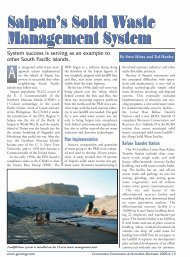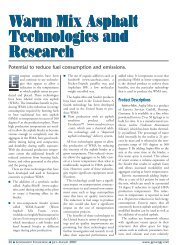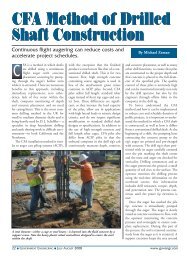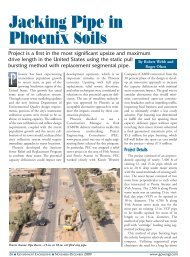Ortho-Polyphosphate Corrosion Inhibitors - Government ...
Ortho-Polyphosphate Corrosion Inhibitors - Government ...
Ortho-Polyphosphate Corrosion Inhibitors - Government ...
Create successful ePaper yourself
Turn your PDF publications into a flip-book with our unique Google optimized e-Paper software.
<strong>Ortho</strong>-<strong>Polyphosphate</strong><br />
<strong>Corrosion</strong> <strong>Inhibitors</strong><br />
Since the late 1980s, a new type of corrosion inhibitor has become<br />
increasingly popular in treating many water supplies. These inhibitors,<br />
classified as ortho/polyphosphate blends, represent a blend of two<br />
previous technologies that have been established over a much longer<br />
period of time. What follows is a bit about the history of<br />
ortho/polyphosphates, their mode of action, and applications where<br />
they may be likely to yield results.<br />
P<br />
olyphosphates (and when<br />
combined with a zinc source<br />
is sometimes referred to as<br />
bimetallic phosphates) have<br />
been used in treating drinking<br />
water supplies since the 1950s.<br />
<strong>Ortho</strong>phosphates (specifically zinc<br />
orthophosphates) were first used in the<br />
late 1960s by Long Beach, CA. As<br />
polyphosphates will revert to the<br />
orthophosphate form over a period of<br />
time, the use of ortho/polyphosphate<br />
blends has actually been going on for as<br />
long a time as polyphosphates have been<br />
used in treating potable water. It was<br />
not, however, until the 1980s that some<br />
vendors began intentionally adding<br />
orthophosphate to a polyphosphate<br />
source to market a blended product.<br />
Today a full range of phosphate products<br />
with or without the addition of zinc<br />
is available.<br />
Composition and<br />
Mode of Action<br />
As the name implies, an<br />
ortho/polyphosphate blend is a product<br />
containing concentrations of an<br />
orthophosphate and polyphosphate<br />
source. As is the case with all phosphate<br />
based inhibitors, the properties of corrosion<br />
protection can be directly attributed<br />
to the film forming action of the<br />
inhibitor on the surface of the material<br />
being protected. The more uniform and<br />
tenacious the film, the better the corrosion<br />
protection. This film forming<br />
action can be the result of a number of<br />
mechanisms with the two most prevalent<br />
being either anodic or cathodic<br />
deposition. Without going into great<br />
detail, it is important to note that the<br />
deposition of a protective film is<br />
dependent essentially on a chemical precipitation<br />
process in the immediate area<br />
of the corroding surface. The environment<br />
within which this<br />
precipitation/film forming process takes<br />
place is typically different in some way<br />
from the bulk water environment. It is<br />
these differences that “trigger” the precipitation<br />
that leads to the deposition of<br />
the protective barrier that stifles further<br />
corrosion.<br />
An example of the above would be<br />
illustrated by the pH change that occurs<br />
in cathodic and anodic sites on a corroding<br />
metal. The solubility of various<br />
phosphate salts and compounds is often<br />
pH dependent. As the phosphate passes<br />
through the cathodic or anodic sites<br />
where the pH differs from that of the<br />
bulk water supply, the phosphate undergoes<br />
a change that results in the precipitation<br />
of a phosphate containing compound,<br />
which, hopefully, will attach<br />
itself to the active anode or cathode.<br />
Some of these compounds may form at<br />
higher and others lower pHs than the<br />
bulk water pH, which will determine<br />
whether the inhibitor is acting as a<br />
anodic or cathodic corrosion inhibitor.<br />
While the pH is probably the most<br />
active player in promoting this film<br />
forming process, other factors undoubtedly<br />
play a role as well. Examples of<br />
these other factors likely include differences<br />
in oxidation potentials, corrosion<br />
byproducts, concentrations and chemical<br />
form of the phosphate, concentrations<br />
of other organic or inorganic compounds,<br />
or a combination of factors<br />
which, when present simultaneously,<br />
trigger the precipitation/film forming<br />
process.<br />
Selection of <strong>Ortho</strong>/Poly Ratio<br />
This is probably the most difficult and<br />
fickle step to undertake in the proper<br />
selection of the inhibitor. This is because,<br />
as previously mentioned, there are many<br />
factors that effect the film forming<br />
process that are not fully understood. As<br />
all waters differ from one another in their<br />
respective chemical makeup, it is virtually<br />
impossible to predict the effects of one<br />
ratio against another without experimentation.<br />
As it is known that both the ortho<br />
and poly forms of phosphate will form<br />
protective films under certain conditions,<br />
it cannot be determined which form<br />
should be maximized without a fair<br />
amount of study.<br />
Having said this, there are several theories<br />
regarding the role that each form<br />
plays in the film forming process. One<br />
popular theory rests on the known fact<br />
that polyphosphate will act to sequester<br />
cations in aqueous solutions while<br />
orthophosphates will not. It is also<br />
48 ■ GOVERNMENT ENGINEERING ■ SEPTEMBER–OCTOBER 2006 www.govengr.com
known that this sequestration property<br />
of polyphosphates has synergistic<br />
effects, which means that a small<br />
amount of polyphosphate will sequester<br />
a large amount of reactive cations.<br />
According to this theory, only enough<br />
polyphosphate should be added to the<br />
water supply to ensure that adequate<br />
sequestration takes place. An overdose<br />
of polyphosphate will act to “strip” the<br />
protective orthophosphate film so its<br />
concentrations should be minimized.<br />
Once the reactive cations (i.e., calcium,<br />
iron, and manganese) have been<br />
sequestered, which results in the concentrations<br />
of polyphosphate being consumed<br />
in this process, the orthophosphates<br />
will have the opportunity to react<br />
in the anodic or cathodic sites to form a<br />
protective film. In the absence of sufficient<br />
polyphosphate to sequester these<br />
reactive cations, the orthophosphate<br />
concentrations are consumed by forming<br />
premature precipitates with these<br />
cations rendering their resulting concentrations<br />
to be too low to form protective<br />
films at the actively corroding sites.<br />
Essentially, the polyphosphate plays the<br />
role of the sacrificial lamb in allowing<br />
the orthophosphate to remain available<br />
to do its job.<br />
Of course, if the application of the<br />
inhibitor is for sequestration purposes,<br />
the answer is easy. Choose the inhibitor<br />
with the best bang for the buck to maximize<br />
polyphosphate concentrations. It<br />
is doubtful that the presence of<br />
orthophosphate will be of any value in<br />
sequestering any metals in solution.<br />
Conclusions<br />
<strong>Ortho</strong>/polyphosphate corrosion<br />
inhibitors can often times be the best<br />
choice in selecting an inhibitor to solve<br />
a corrosion related problem. They are<br />
more environmentally friendly than<br />
some of the other alternatives as they<br />
contain no zinc, which can sometimes<br />
be considered objectionable. As they<br />
can, however, contribute to the growth<br />
of algae in open reservoirs, their use<br />
should be applied with caution where<br />
open reservoirs exist.<br />
GE<br />
The preceding is courtesy of Sweetwater<br />
Technologies, www.sweetwatertech.com.<br />
Part 5 of this series will discuss potable<br />
organic polymers—types and applications.<br />
www.govengr.com GOVERNMENT ENGINEERING ■ SEPTEMBER–OCTOBER 2006 ■ 49










